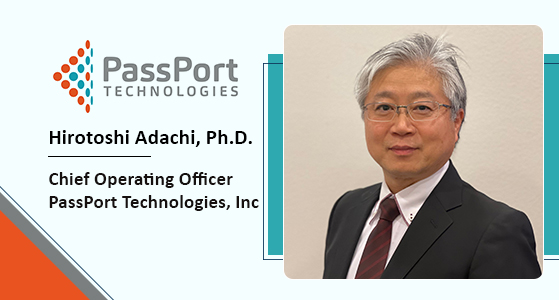
Redefining the Future of Needle-Free Drug Delivery
In a world where patient comfort, precision, and efficiency are more important than ever, PassPort Technologies is redefining how medicines are delivered. Spearheaded by Hirotoshi Adachi, Ph.D., COO, the company’s innovative transdermal platform offers a powerful alternative to injections—delivering a wide range of therapeutics through a smart, painless patch system.
Remind us how the PassPort System works?
The PassPort System operates through a remarkably straightforward yet highly advanced process designed to optimize drug delivery without the use of needles. The device functions by creating microscopic pores in the outer layer of the skin—precisely and painlessly—within milliseconds. Following this, a specially engineered dry patch is placed directly over the treated area. The body’s natural interstitial fluid then rises to the skin’s surface through these micropores, dissolving the drug embedded in the patch. Once dissolved, the medication is transported back through the pores into the epidermis and enters the systemic circulation.
What sets the PassPort System apart is the unprecedented control it offers. The technology allows for customization of both the number and size of the micropores, as well as the drug formulation itself. This flexibility enables either a rapid or a sustained release of the medication, tailored to specific therapeutic needs. In comparison to traditional subcutaneous injections, the PassPort System is not only more comfortable and user-friendly but also more efficient in delivering drugs to the body—making it a transformative solution in transdermal drug delivery.
What motivated the spin-out of PassPort Technologies from Nitto Denko in 2019? And how has the company evolved since?
The spin-out of PassPort Technologies from Nitto Denko in 2019 was a strategic move driven by the need for greater agility and focus. While being part of a large global organization offered significant resources and support, it also came with structural limitations that made it challenging to move quickly in the dynamic biotech landscape. Recognizing that innovation in life sciences requires speed, adaptability, and specialized decision-making, the team opted to become an independent entity. With the backing of a life sciences-focused venture capital fund, PassPort Technologies gained the freedom to operate with a sharper focus on transdermal drug delivery innovation.
Since the spin-out, the company has undergone a remarkable evolution. It has transitioned from a primarily research-driven entity to one actively engaged in translational medicine. Today, PassPort is advancing clinical trials that explore the delivery of a wide range of therapeutics, from small molecule drugs to more complex peptides and proteins. The company is also forging valuable partnerships with pharmaceutical firms, enabling it to bring its technology closer to real-world healthcare applications and patient impact.
How do you prioritize and select drug candidates for your transdermal system?
At PassPort Technologies, the selection of drug candidates for our transdermal system begins with a fundamental question, where can we deliver the greatest impact for patients and healthcare providers? Our priority is to identify therapies where traditional delivery methods particularly injections pose challenges due to bioavailability limitations, complexity or discomfort. We focus on improving pharmacokinetics, reducing side effects and enhancing patient convenience through a needle-free solution.
Key areas of interest include post-surgical therapies that can be administered at home, reducing the need for clinical follow-ups; large-scale vaccination programs where ease of use, safety and scalability are essential; and chronic conditions where gastrointestinal absorption limits the efficacy of oral medications. Our goal is to address unmet clinical needs with meaningful, patient-centric innovations.
While water solubility is advantageous for our platform, it is not a strict requirement. We have successfully formulated and delivered a wide range of therapeutic modalities—including small molecules, peptides, proteins, oligonucleotides and even mRNA-LNPs. Ultimately, we move forward with candidates that align patient benefits with strong market needs and technical feasibility, aiming to create both first-in-class and best-in-class solutions.
Are you planning to expand into other therapeutic areas?
Yes, we are actively expanding into new therapeutic areas and in fact, we already have. Our lead programs now include treatments for acute migraine and early-stage Alzheimer’s disease, both of which showcase the unique capabilities of our transdermal system. In the case of migraine, our patch delivers rapid systemic absorption comparable to an injection, offering a needle-free, at-home solution for acute relief an approach that could significantly improve patient comfort and accessibility.
Our Alzheimer’s program has delivered even more groundbreaking results. We’ve demonstrated the ability to deliver a therapeutic peptide across the blood-brain barrier, achieving 20 to 40 times higher bioavailability than intravenous administration. This is a significant milestone, suggesting that our technology can be used to non-invasively reach central nervous system (CNS) targets an area that has traditionally been very difficult to access.
Additionally, we’re advancing early-stage feasibility programs in other high-impact areas, including GLP-1 analogs for metabolic diseases, mRNA vaccines, and large-molecule therapeutics. These preclinical efforts are showing great promise, and they underscore our commitment to broadening the reach and potential of needle-free drug delivery.
How do partnerships with pharma and academia enhance your development efforts?
Partnerships with pharmaceutical companies and academic institutions are central to our development strategy. Our goal is to enable, not compete with, drug discovery efforts. We don’t create new molecules ourselves instead, we collaborate with partners to enhance the delivery of their compounds, especially when traditional oral or injectable methods fall short. These partnerships allow us to apply our transdermal platform in targeted, high-impact ways while our collaborators focus on therapeutic innovation. By combining their scientific expertise with our delivery technology, we create more effective and patient-friendly solutions. These collaborations also help streamline the path from lab research to clinical application, providing drug developers with a powerful tool to improve treatment outcomes.
What’s your commercialization strategy for the PassPort System?
Our commercialization strategy centers on out-licensing and collaborative product development. Rather than bringing products to market independently, we partner with pharmaceutical and biopharma companies to integrate the PassPort System into their therapeutic pipelines. Our platform offers a delivery solution that is difficult for traditional pharma to replicate, allowing us to fill a critical capability gap. By customizing the system for various compounds, we enable partners to maintain full control of their drug programs while enhancing delivery, efficacy, and patient experience. The goal is to become the preferred delivery partner versatile across therapeutic areas, precise enough to meet rigorous clinical and regulatory standards, and simple enough to integrate seamlessly into patients’ daily lives.
How do you position PassPort in the competitive drug delivery space?
PassPort Technologies is redefining transdermal drug delivery by going beyond traditional passive patch systems. While most patches rely on the natural diffusion of drugs through the skin, our system is active—creating controlled micropores to enable the delivery of a wide range of therapeutics, including those typically limited to injection. This results in faster onset, higher bioavailability, and precise control over the drug release profile. It also reduces the need for medical supervision, making treatments more accessible and cost-effective.
What truly sets us apart is our focus on user experience. We design with the patient in mind—considering how the device fits into daily life and medication routines. Every aspect of the system, from dosage timing to comfort and usability, is customizable. This patient-first approach represents a significant shift from traditional protocol-driven design and helps position PassPort as a uniquely capable, user-centered platform in a competitive drug delivery landscape.
What’s the leadership team’s long-term vision?
The leadership team’s long‑term vision is to transform transdermal delivery from a niche alternative into a first‑choice modality across the pharmaceutical landscape. Historically, patches have been relegated to secondary roles, often considered only after oral or injectable routes have been locked in. Our goal is to flip that paradigm by demonstrating that, with the right technology, transdermal can be best‑in‑class for a wide array of therapies.
To achieve this, we’re committed to ongoing education and rigorous clinical demonstration, showcasing superior pharmacokinetics, patient compliance, and cost‑effectiveness. We aim to embed PassPort early in the drug development lifecycle, ensuring delivery considerations are front and center rather than an afterthought. By relentlessly focusing on patient outcomes and collaborating with industry stakeholders, we intend to build the momentum necessary to make transdermal delivery a mainstream option, driving better care through better delivery.
“Where innovation meets patient comfort—transdermal delivery, reimagined.”
“From lab to life: transforming therapies through smarter, seamless drug delivery.”


Company Name : PassPort Technologies, Inc
Website : https://passport-tech.com/
Management Team
Hirotoshi Adachi, Ph.D. | COO







